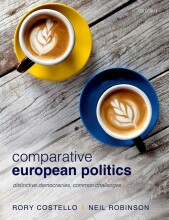Summary: The Governance And Politics Of Social Problems
- This + 400k other summaries
- A unique study and practice tool
- Never study anything twice again
- Get the grades you hope for
- 100% sure, 100% understanding
Read the summary and the most important questions on The governance and politics of social problems
-
Lectures
This is a preview. There are 29 more flashcards available for chapter 11/12/2020
Show more cards here -
What are the four models of representation?
- Trustees => Experts/The most clever among us have to make the decisions because they can do this best. That does not mean a form of elitism, because they are smart enough to keep political stability.
- Delegates => The representatives have to consult the electorate in what they should be voting for, even if this goes against the opinion of the representative themselves.
- Mandates => Political parties write a program where is written down what the representatives will try to accomplish when the voters choose them.
- Resemblance => You have to search for people that look like you and resemble you the most.
-
What is partisan dealignment?
A decline in the extent to which people relate themselves with a certain party by identifying themselves with it. More swing/floating voters. Usually there was a strong link between voter groups and their identities and their party preference. -
What is the essence of Hall & Soskice's article?
In countries with a very high employer-employee relationship, products can be much more sophisticated, but in countries with a weak bond and uncertainty, there is high levels of development -
Why are populists against pluralism and elitism?
Populists are both against pluralism (because it fragments the people and the people are one) and against elitism (because they don’t listen to the people) -
What are the main functions of political parties?
1) opinion-making, they (2) integrate and aggregate interests, they (3) promote people to engage with politics, they (4) organize themselves to be government (or opposition) and they have a (5) representation function. -
What are political entrepeneurs?
Political entrepreneurs stand completely outside of the political game, but they are focused on business and private wealth. They have no real membership organizations and all activities are in the market. Geert Wilders is the ultimate example of this; he hasn’t got a party organization and you don’t need a policy program either. -
What are the deepening and widening effects of the EU?
Deepening = the treaties and power is moving towards the EU
Widening = there are more member states -
What is the main difference between STV and AV?
With AV, you have only one candidate that wins. You select the candidates per how you like them and the first that gets to 50% wins. STV is with multiple candidates that has a kiesdeler, the first that get to that win also -
What are the four reactions about the alignment of politics?
- Zero-cleavage thesis => There is no cleavage anymore, and politics is unstructured
- Cleavage stability thesis => Traditional parties still dominate, so it’s stable.
- Cleavage-replacement => We are moving into a post-materialist world and the generation/level of education matters
- Cleavage-reboot => There is still a cleavage, but other problems are important; before abortion/women rights and now about Islam.
-
What are the theories about an ultimate size for governance?
- Dahl and Tufte (1973) argue that the size of a democratic unit decides its performance: small communities that govern themselves are better for the input legitimacy. Larger communities have a larger output legitimacy because they can provide better services to people and provide safety
- Higher grades + faster learning
- Never study anything twice
- 100% sure, 100% understanding





























